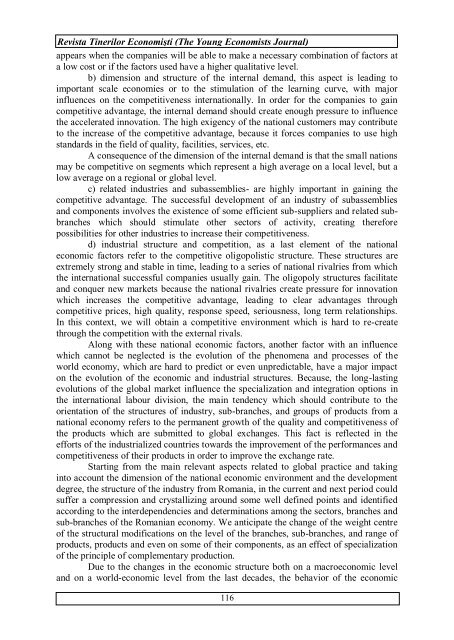Implications of change management in public administration
Implications of change management in public administration
Implications of change management in public administration
Create successful ePaper yourself
Turn your PDF publications into a flip-book with our unique Google optimized e-Paper software.
Revista T<strong>in</strong>erilor Economişti (The Young Economists Journal)<br />
appears when the companies will be able to make a necessary comb<strong>in</strong>ation <strong>of</strong> factors at<br />
a low cost or if the factors used have a higher qualitative level.<br />
b) dimension and structure <strong>of</strong> the <strong>in</strong>ternal demand, this aspect is lead<strong>in</strong>g to<br />
important scale economies or to the stimulation <strong>of</strong> the learn<strong>in</strong>g curve, with major<br />
<strong>in</strong>fluences on the competitiveness <strong>in</strong>ternationally. In order for the companies to ga<strong>in</strong><br />
competitive advantage, the <strong>in</strong>ternal demand should create enough pressure to <strong>in</strong>fluence<br />
the accelerated <strong>in</strong>novation. The high exigency <strong>of</strong> the national customers may contribute<br />
to the <strong>in</strong>crease <strong>of</strong> the competitive advantage, because it forces companies to use high<br />
standards <strong>in</strong> the field <strong>of</strong> quality, facilities, services, etc.<br />
A consequence <strong>of</strong> the dimension <strong>of</strong> the <strong>in</strong>ternal demand is that the small nations<br />
may be competitive on segments which represent a high average on a local level, but a<br />
low average on a regional or global level.<br />
c) related <strong>in</strong>dustries and subassemblies- are highly important <strong>in</strong> ga<strong>in</strong><strong>in</strong>g the<br />
competitive advantage. The successful development <strong>of</strong> an <strong>in</strong>dustry <strong>of</strong> subassemblies<br />
and components <strong>in</strong>volves the existence <strong>of</strong> some efficient sub-suppliers and related subbranches<br />
which should stimulate other sectors <strong>of</strong> activity, creat<strong>in</strong>g therefore<br />
possibilities for other <strong>in</strong>dustries to <strong>in</strong>crease their competitiveness.<br />
d) <strong>in</strong>dustrial structure and competition, as a last element <strong>of</strong> the national<br />
economic factors refer to the competitive oligopolistic structure. These structures are<br />
extremely strong and stable <strong>in</strong> time, lead<strong>in</strong>g to a series <strong>of</strong> national rivalries from which<br />
the <strong>in</strong>ternational successful companies usually ga<strong>in</strong>. The oligopoly structures facilitate<br />
and conquer new markets because the national rivalries create pressure for <strong>in</strong>novation<br />
which <strong>in</strong>creases the competitive advantage, lead<strong>in</strong>g to clear advantages through<br />
competitive prices, high quality, response speed, seriousness, long term relationships.<br />
In this context, we will obta<strong>in</strong> a competitive environment which is hard to re-create<br />
through the competition with the external rivals.<br />
Along with these national economic factors, another factor with an <strong>in</strong>fluence<br />
which cannot be neglected is the evolution <strong>of</strong> the phenomena and processes <strong>of</strong> the<br />
world economy, which are hard to predict or even unpredictable, have a major impact<br />
on the evolution <strong>of</strong> the economic and <strong>in</strong>dustrial structures. Because, the long-last<strong>in</strong>g<br />
evolutions <strong>of</strong> the global market <strong>in</strong>fluence the specialization and <strong>in</strong>tegration options <strong>in</strong><br />
the <strong>in</strong>ternational labour division, the ma<strong>in</strong> tendency which should contribute to the<br />
orientation <strong>of</strong> the structures <strong>of</strong> <strong>in</strong>dustry, sub-branches, and groups <strong>of</strong> products from a<br />
national economy refers to the permanent growth <strong>of</strong> the quality and competitiveness <strong>of</strong><br />
the products which are submitted to global ex<strong>change</strong>s. This fact is reflected <strong>in</strong> the<br />
efforts <strong>of</strong> the <strong>in</strong>dustrialized countries towards the improvement <strong>of</strong> the performances and<br />
competitiveness <strong>of</strong> their products <strong>in</strong> order to improve the ex<strong>change</strong> rate.<br />
Start<strong>in</strong>g from the ma<strong>in</strong> relevant aspects related to global practice and tak<strong>in</strong>g<br />
<strong>in</strong>to account the dimension <strong>of</strong> the national economic environment and the development<br />
degree, the structure <strong>of</strong> the <strong>in</strong>dustry from Romania, <strong>in</strong> the current and next period could<br />
suffer a compression and crystalliz<strong>in</strong>g around some well def<strong>in</strong>ed po<strong>in</strong>ts and identified<br />
accord<strong>in</strong>g to the <strong>in</strong>terdependencies and determ<strong>in</strong>ations among the sectors, branches and<br />
sub-branches <strong>of</strong> the Romanian economy. We anticipate the <strong>change</strong> <strong>of</strong> the weight centre<br />
<strong>of</strong> the structural modifications on the level <strong>of</strong> the branches, sub-branches, and range <strong>of</strong><br />
products, products and even on some <strong>of</strong> their components, as an effect <strong>of</strong> specialization<br />
<strong>of</strong> the pr<strong>in</strong>ciple <strong>of</strong> complementary production.<br />
Due to the <strong>change</strong>s <strong>in</strong> the economic structure both on a macroeconomic level<br />
and on a world-economic level from the last decades, the behavior <strong>of</strong> the economic<br />
116















